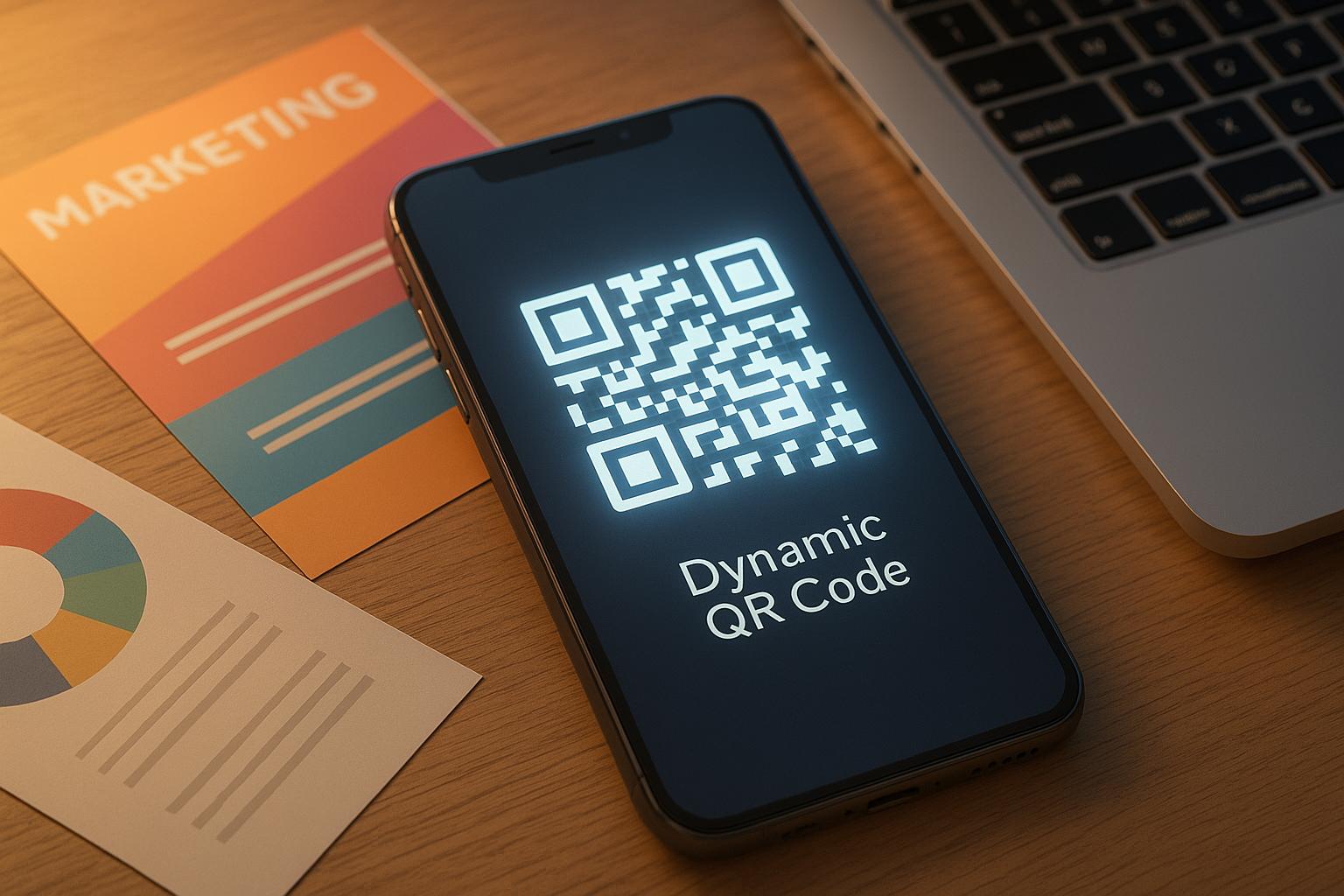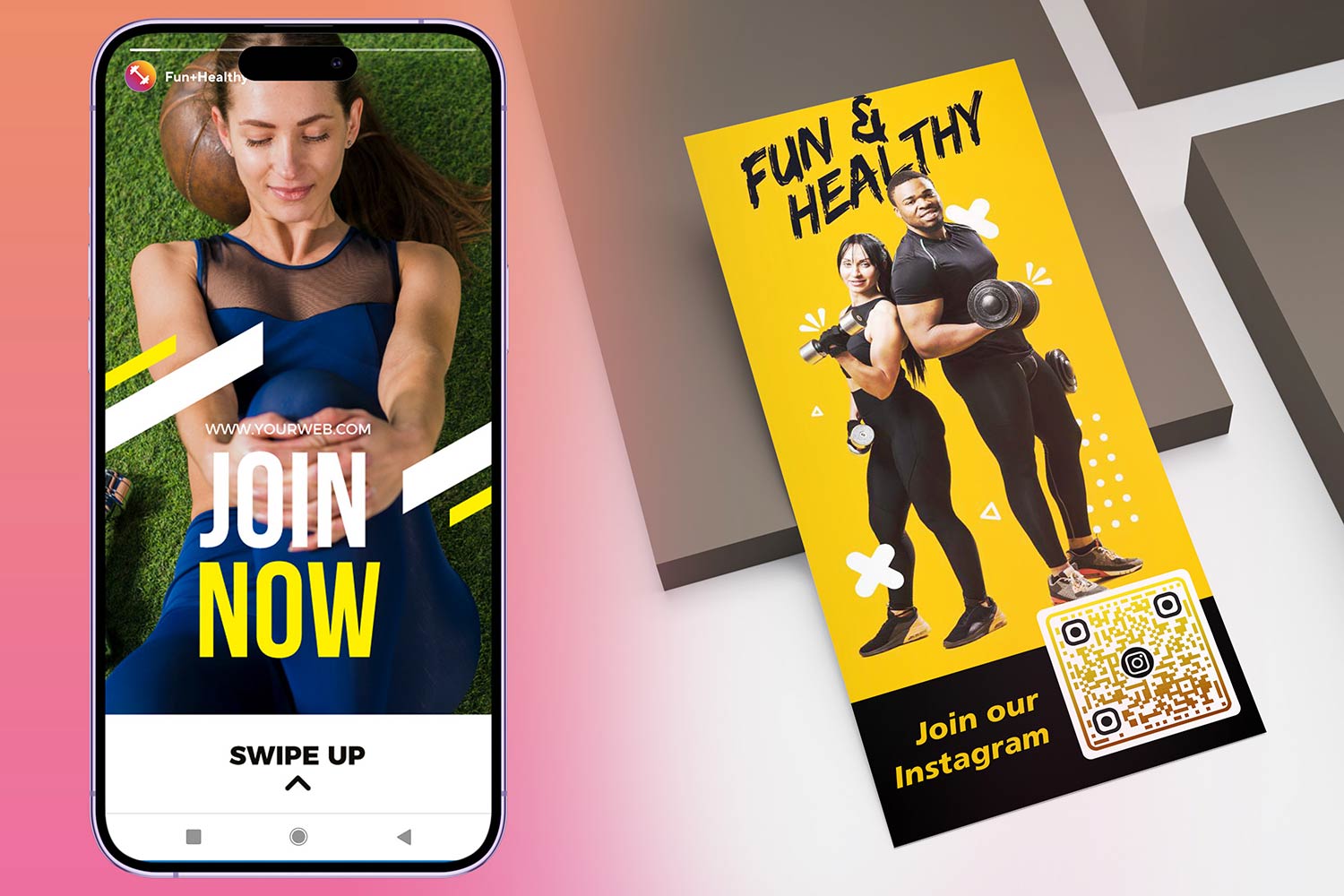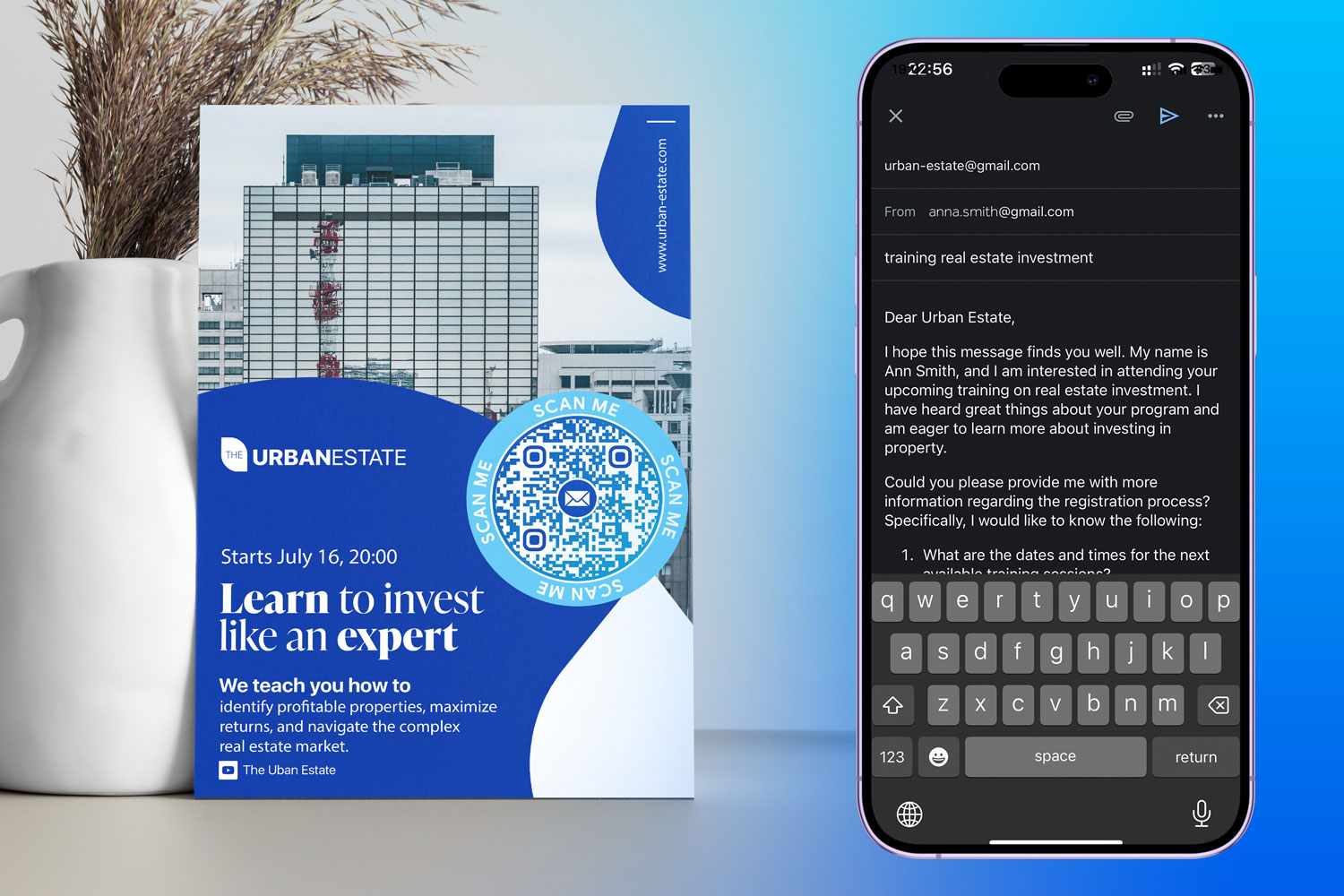Dynamic QR codes are transforming marketing by offering flexibility, real-time updates, and detailed tracking. Here’s what you need to know:
- Update content anytime: No need to reprint materials – change linked content instantly.
- Track performance: Get data on scans, including time, location, and device details.
- Custom branding: Design QR codes with your logo and colors to boost engagement.
- Personalized campaigns: Automate and tailor customer experiences based on behavior.
- Save costs: Reduce printing expenses and enhance security with advanced features.
Quick Comparison: Static vs. Dynamic QR Codes
| Feature | Static QR Codes | Dynamic QR Codes |
|---|---|---|
| Editability | Fixed, not changeable | Fully editable |
| Tracking | Not available | Detailed analytics |
| Cost Efficiency | Requires reprints | No reprints needed |
| Branding Options | Basic customization | Advanced customization |
| Security Features | Limited | Passwords, scan limits |
Dynamic QR codes are a smarter choice for campaigns needing flexibility, tracking, and personalization. They help businesses save money while staying adaptable to changing needs.
What Are Dynamic QR Codes And How Do They Help With Traffic? – Marketing and Advertising Guru
1. Easy content updates without reprinting
Dynamic QR codes make it simple to update content instantly without the hassle of reprinting materials. Unlike static QR codes, which are locked to fixed data, dynamic QR codes work through a permanent URL that redirects to a link you can change anytime. This means you can quickly adjust details like contact information, event locations, or promotional offers in just a few clicks.
This flexibility has already proven to save businesses a lot of money. Take Marriott Aruba, for example. After COVID-19, they swapped out all their restaurant print menus for dynamic QR codes. The result? They saved approximately $150,000 by cutting out printing costs. Even better, their QR code menus automatically switch between breakfast, lunch, and dinner options based on the time of day – no manual updates needed.
The savings extend beyond hospitality. Large corporations printing 25,000 manuals annually can save around $5,000 by using a PDF QR code approach. Restaurants, too, benefit from swapping disposable menus for QR code menus. While printing 500 disposable menus can cost up to $500, dynamic QR code menus only cost $160–$180 per year.
Beyond cost savings, dynamic QR codes are also helping companies like Ferrara comply with U.S. bioengineered food disclosure standards. With thousands of product SKUs, Ferrara uses these QR codes to share GMO information. When regulations or formulations change, they can instantly update the linked content without needing to reprint packaging across their entire product range.
Industries such as real estate, education, restaurants, and marketing agencies are also reaping the rewards of this feature. For instance, real estate agents can update property listings and prices on flyers and business cards without reprinting. Similarly, schools can revise course schedules or details throughout the semester using the same QR codes on printed materials.
This ability to update content on the fly opens up opportunities for more agile marketing strategies. By creating dynamic QR codes, you ensure your materials stay relevant and up-to-date. Pageloot‘s dynamic QR code solution even lets you track performance in real time, making it easier to keep your campaigns current. Want to try it yourself? Check out our free QR generator. With QR code usage on the rise, it’s estimated that nearly 99.5 million U.S. consumers will scan QR codes with their smartphones by 2025.
And let’s not forget the environmental perks. By reducing the need for constant reprinting, dynamic QR codes cut down on paper waste and save valuable printing resources. This approach not only trims your budget but also supports more eco-conscious marketing efforts, making dynamic QR codes a smart choice for businesses looking to stay efficient and environmentally responsible.
2. Detailed tracking and analytics
Dynamic QR codes bring a powerful advantage to your marketing efforts by providing detailed scan analytics. These codes don’t just track the total and unique scan counts – they also capture precise scan times, location data (down to cities or regions), and device details. All of this helps fine-tune your campaigns for better results.
The use of QR codes in marketing is growing rapidly. Back in 2021, 45% of U.S. consumers used QR codes to access promotional offers. Fast forward to 2022, and 89 million Americans were scanning them – a number that’s only expected to rise as mobile usage continues to grow.
One standout feature of dynamic QR codes is real-time tracking. Marketers can monitor engagement as it happens, gathering data on browser types, operating systems, language preferences, and GPS-based scan locations. This level of detail opens the door to more precise campaign adjustments.
Dynamic QR codes also make A/B testing incredibly simple. You can test multiple landing pages or offers using the same code, allowing you to quickly determine which version resonates most with your audience. With QR codes already known for driving engagement, this testing capability takes optimization to the next level.
When you use tools like Pageloot’s platform to create a QR code, you unlock access to these advanced analytics. Whether you’re tracking menu interactions in a restaurant or measuring the impact of business cards at a networking event, dynamic QR codes transform every scan into actionable insights. This data empowers you to refine your strategy and get the most out of your marketing efforts.
3. Custom design and branding options
Dynamic QR codes take basic QR codes to the next level by transforming them into branded marketing tools that reflect your company’s identity. Unlike static codes, dynamic QR codes offer a wide range of customization options, making your brand more recognizable while keeping the code fully functional.
Here’s a compelling stat: customized QR codes can drive up to 200% more scans compared to plain ones, with 70% of users motivated to scan based on branding alone. By integrating your brand’s design elements, you not only enhance visibility but also encourage more engagement in real-world campaigns.
The benefits of customization are clear, and real-world examples show how impactful these changes can be. By using your brand colors, logos, and even unique shapes, you can build trust and recognition. For the best results, maintain at least a 55% contrast between the code’s foreground and background to ensure scannability. Plus, your logo can cover up to 30% of the QR code area without compromising its readability.
Big brands have already tapped into the potential of custom QR codes. For example, Guinness created a campaign featuring custom mugs that revealed a QR code when filled with their beer, giving users access to exclusive promotions. Similarly, PUMA embedded dynamic QR codes into their LQD Cell Origin Air sneakers, unlocking augmented reality experiences through their branded app.
Dynamic QR codes also make it easy to keep your campaigns flexible and up-to-date. Using a QR code generator with logo, you can create branded codes that fit seamlessly across various marketing materials – whether it’s business cards, flyers, or product packaging. This ensures your branding stays consistent across all touchpoints.
Another tip? Add frames and a clear call-to-action, like "Scan to order", to encourage immediate interaction. This strategy works especially well in settings like restaurant menus or retail stores, where quick actions are essential.
Dynamic QR codes allow you to create unified campaigns where design, content, and user experience come together seamlessly. They not only reinforce your brand identity but also adapt as your branding evolves over time.
sbb-itb-74874c9
4. Marketing automation and personalization
Dynamic QR codes do more than just update content in real time – they integrate effortlessly with automation systems to deliver personalized customer experiences. This connection enables businesses to create automated, tailored customer journeys that feel seamless and intuitive.
By linking with tools like HubSpot and Zapier, dynamic QR codes can do some heavy lifting: automatically generating QR codes for new campaigns, capturing leads directly into your CRM, and triggering follow-up actions based on how and when users interact with the codes.
"Statistics show that buyers don’t do that. They want to learn at their own pace and be reached when they need more information or are ready to buy. A well-constructed marketing automation strategy makes that a reality." – John McTigue, Marketing Expert
Take time-based personalization as an example. Restaurants can use dynamic QR codes to automatically switch menus throughout the day – showing breakfast options from 6:00 AM to 10:00 AM, lunch from 12:00 PM to 3:00 PM, and dinner from 7:00 PM to 10:00 PM. This eliminates the need for manual updates, and it’s a feature that 52% of businesses using QR codes for menus actively request.
These personalized QR experiences consistently outperform traditional outreach methods. QR-linked content achieves engagement rates 3–4× higher, while QR-driven customer journeys boast an average click-through rate of 37% [10,51].
Personalization doesn’t stop at timing – it can extend to location, device type, and user behavior. For instance, a gaming company used player data to craft personalized messaging through QR codes. By syncing this data with their marketing platform, they delivered re-engagement offers and loyalty rewards tailored to individual gaming habits. The results? A 30% increase in player retention, a 25% rise in in-game purchases, and a 20% boost in loyalty program participation.
If you’re just starting out, keep it simple. Begin with basic automation, like showing different content during business hours versus after-hours. Over time, you can introduce more advanced rules. Always include fallback URLs for scans that don’t meet specific conditions, and test thoroughly to ensure smooth transitions. Platforms like Pageloot make it easy to create a QR code that integrates with your existing marketing tools to deliver these personalized experiences.
Dynamic QR codes also excel at lead generation and feedback collection. They can guide users to tailored landing pages, capture form submissions directly into your CRM, and kick off targeted nurture campaigns. This ensures every scan is more than just an interaction – it’s an opportunity to engage and collect valuable data.
With 95% of businesses confirming that QR codes help gather critical first-party data and 62% predicting increased sales by 2025 due to QR-driven strategies, combining automation with personalization through dynamic QR codes is a game-changer [10,51].
5. Cost savings and security features
Dynamic QR codes offer a smart way to save money while safeguarding your business and customer data. For marketers who need to stay on budget without compromising security, these codes are a game changer. The immediate cost reductions they provide also lead to better campaign management and stronger security measures.
One of the biggest advantages of dynamic QR codes is that they eliminate the need for constant reprinting. Traditional marketing materials often become obsolete when details like prices, promotions, or contact information change. With dynamic QR codes, you can update the linked content instantly without having to reprint anything. For example, businesses using PDF QR codes to replace printed manuals can save as much as $4,940 annually by avoiding the reprinting of 25,000 manuals. Similarly, companies using QR codes for business cards can cut printing costs by up to 98%. Even for a team of 500 employees, digital business card solutions cost just $1,188 per year.
On top of cost savings, dynamic QR codes come with advanced security features that static codes simply can’t match. Features like password protection, scan limits, expiration dates, and access monitoring help control who can access your information and when. These codes also benefit from platform-level encryption, adding an extra layer of protection to sensitive data.
| Feature | Cost Impact | Security Benefit |
|---|---|---|
| Content updates | Cuts reprinting costs | Prevents outdated information risks |
| Password protection | Reduces need for printed secure materials | Blocks unauthorized access |
| Scan limits | Avoids waste from over-distribution | Controls information sharing |
| Access monitoring | Optimizes marketing spend | Detects potential security breaches |
Using Pageloot to create dynamic QR codes ensures you get both cost efficiency and the security features needed for professional campaigns. This is especially valuable for marketing agencies handling multiple client accounts. With competitive pricing for dynamic QR codes, the savings from reduced printing costs combined with enhanced security make the investment worthwhile.
Additionally, businesses leveraging QR code analytics can pinpoint which campaigns are working and cut back on ineffective spending. This data-driven approach helps ensure every dollar is spent wisely, all while maintaining the high security standards modern businesses require.
Dynamic vs Static QR Codes Comparison
Understanding the distinction between dynamic and static QR codes is key to choosing the right option for your marketing efforts. While both connect physical and digital experiences, their features and functionality differ significantly, which can influence the success of your campaigns.
The main difference lies in how each type stores and handles information. Static QR codes embed data directly into the image, making them permanent and unchangeable. On the other hand, dynamic QR codes use a short URL that redirects to your target destination, allowing you to update the destination without changing the physical code itself.
This flexibility gives dynamic QR codes a clear edge. Patrick Augstein, Customer Support Team Manager at Bitly, highlights this advantage:
"Dynamic QR Codes are miles ahead of their Static counterparts in both functionality and flexibility, making them a versatile choice for various applications."
Dynamic QR codes also excel in tracking and analytics. While static codes provide no performance insights, dynamic codes can gather detailed data such as the number of scans, the date and time of each scan, and even location details.
Here’s a quick comparison of key features:
| Feature | Static QR Codes | Dynamic QR Codes |
|---|---|---|
| Editability | Fixed, cannot be updated | Fully editable even after printing |
| Tracking & Analytics | No tracking available | Provides detailed scan data and analytics |
| Retargeting | Not possible | Enables online retargeting |
| URL Structure | Long and complex URLs | Short, clean URLs |
| Scan Speed | Slower to scan | Faster scanning |
| Campaign Management | Limited to one-time use | Supports scheduled campaigns and A/B testing |
| Branding Options | Basic customization | Advanced branding and design options |
These differences go beyond convenience. Dynamic QR codes are faster to scan, thanks to their cleaner URLs, and they allow marketers to retarget users online, schedule campaigns, and even test different messages to see what resonates best. For instance, if you’re running a campaign using QR codes on flyers, dynamic codes let you update the offer without needing to reprint materials – saving both time and money.
Static QR codes, however, still have their place. They’re ideal for fixed information like contact details or a permanent website URL, and they work well for one-time events where tracking isn’t necessary. But for marketing campaigns that require flexibility and performance insights, dynamic QR codes are the better choice.
Even when considering costs, the pricing difference between static and dynamic codes is often minimal. Factor in the savings from avoiding reprints and the value of detailed analytics, and dynamic codes emerge as a smart investment. Many businesses view them as a cost-effective way to optimize campaigns and measure performance over time.
Conclusion
Dynamic QR codes have become a game-changer in marketing, offering measurable growth and versatility. The five key benefits we’ve discussed – easy content updates, detailed tracking and analytics, custom design options, marketing automation features, and cost efficiency with added security – highlight why these codes outperform traditional methods while enabling the collection of crucial first-party data for campaigns.
What truly sets dynamic QR codes apart is their ability to adapt and evolve with your marketing needs. Whether it’s updating promotional offers on business cards, tracking engagement metrics for restaurant menus, or personalizing customer experiences based on behavior, these codes eliminate the need for costly reprints or redesigns, making them a practical and efficient solution.
For marketers looking to maximize these advantages, selecting the right platform is essential. Pageloot’s platform, trusted by over 20,000 brands, offers a complete QR code solution with seamless analytics and customization. With features like real-time tracking, brand-specific designs, and over 25 QR code types, you can create a QR code that not only looks professional but also delivers valuable insights to refine your campaigns.
As marketing strategies continue to evolve, dynamic QR codes remain a powerful tool for bridging physical and digital interactions. They don’t just redefine how campaigns are managed – they elevate customer engagement and deliver measurable results in today’s fast-paced, digital-first world. Start using dynamic QR codes now to turn every interaction into actionable insights.
FAQs
How do dynamic QR codes enhance personalized marketing campaigns?
Dynamic QR codes elevate personalized marketing campaigns by giving businesses the power to update content on the fly without needing to reprint the physical code. This flexibility allows you to fine-tune promotions, messages, or experiences to match specific audiences or situations as they unfold.
On top of that, dynamic QR codes offer in-depth analytics, letting marketers track user behavior, preferences, and interactions. These insights pave the way for more precise and targeted campaigns, whether it’s crafting personalized offers, enabling contactless payments, or streamlining event check-ins. By catering to individual preferences, dynamic QR codes help deliver a more engaging and relevant consumer experience.
How can dynamic QR codes help businesses save costs compared to static ones?
Dynamic QR codes come with cost-saving perks that static QR codes simply can’t match. One of the biggest advantages? You can update the linked content anytime without having to reprint the code. This means no extra expenses on reprinting materials, saving both time and money on production.
Another bonus is the real-time analytics they offer. Businesses can track performance, fine-tune campaigns, and avoid wasting money on strategies that don’t work. While there’s often a subscription fee involved, the flexibility they bring makes them a smart, budget-friendly option for long-term marketing efforts.
How do dynamic QR codes improve security in marketing campaigns?
Dynamic QR codes bring a layer of security to marketing campaigns by offering real-time tracking and the ability to adjust destinations as needed. This means businesses can monitor how their QR codes are being used and respond swiftly if anything seems off. Features like password protection, restricted access, and encrypted data add extra protection for sensitive information.
On top of that, dynamic QR codes are effective in combating scams like phishing, malware, or tampering. If any suspicious activity is spotted, marketers can update or even deactivate the QR code immediately. These features make dynamic QR codes a dependable and secure option for today’s marketing efforts.

























